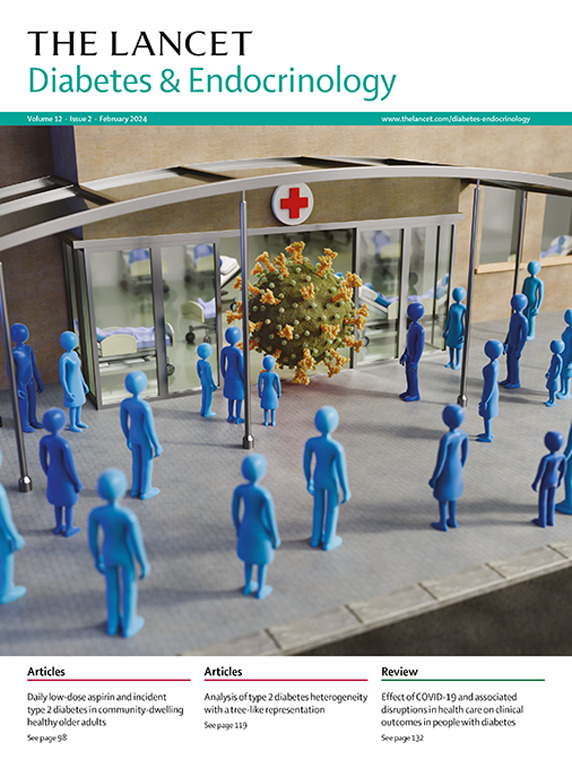每周一次的西马鲁肽7.2 mg成人肥胖(STEP UP):一项随机、对照、3b期试验
IF 41.8
1区 医学
Q1 ENDOCRINOLOGY & METABOLISM
引用次数: 0
摘要
研究背景:每周一次皮下塞马鲁肽2.4 mg被批准用于肥胖及相关并发症患者的体重管理;然而,有些人用这个剂量不能达到他们的治疗目标。我们的目的是测试高剂量的西马鲁肽(7.2 mg)在肥胖人群中的有效性和安全性。step UP是一项3b期、随机、双盲、安慰剂对照和主动对照试验,在11个国家的95家医院、专科诊所和医疗中心进行,受试者为BMI≥30 kg/m2、无糖尿病的成年人。参与者被随机分配(5:1:1),接受每周一次皮下注射西马鲁肽7.2 mg、2.4 mg或安慰剂,并进行生活方式干预,持续72周。主要终点是体重的百分比变化,以及从基线到第72周(治疗政策估计),西马鲁肽7.2 mg与安慰剂相比,体重减少5%或更多的参与者的比例。验证性次要终点是体重的百分比变化(7.2 mg vs . 2.4 mg),腰围(cm)的变化,以及与安慰剂相比体重减轻10%或以上、15%或以上、20%或以上、25%或以上的参与者比例,以及与安慰剂相比体重减轻20%或以上、25%或以上的参与者比例。对所有接受至少一剂试验产品的参与者的安全性进行了评估。该试验已在ClinicalTrials.gov注册(NCT05646706),现已完成。在2023年1月1日至2024年11月26日期间,1407名参与者被随机分配到semaglutide 7.2 mg (n=1005), semaglutide 2.4 mg (n=201)或安慰剂(n=201)组。1407名参与者中,女性1037人(73.7%),平均年龄47岁(SD 12),平均体重113.0 (24.1)kg,平均BMI为39.9 (7.1)kg/m2。西马鲁肽7.2 mg组体重的平均变化大于2.4 mg组(- 18.7% [SE 0.4] vs - 15.6%[0.7];估计治疗差异[ETD] - 3.1% [95% CI - 4.7至- 1.6];p< 0.0001);西马鲁肽7.2 mg组与安慰剂组(- 18.7% [0.4]vs - 3.9%[0.6]; - 14.8%[- 16.2至- 13.4];p< 0.0001)。与安慰剂组相比,西马鲁肽7.2 mg组的参与者更有可能达到5%或更高的体重减轻(优势比为12.1 [95% CI为8.3至17.6];p< 0.0001), 10%或更高(14.5[9.6至21.9];p< 0.0001), 15%或更高(20.3[11.2至36.8];p< 0.0001), 20%或更高(27.3[10.9至68.0];p< 0.0001), 25%或更高(12.4[36.8至44.1];p< 0.0001);与2.4毫克组相比,更有可能达到20%或更高的体重减轻(1.8[1·3至2·4];p= 0.0006)和25%或更高(2.4[1·6至3·5];p= 0.0001)。与安慰剂相比,西马鲁肽7.2 mg组腰围改善(ETD - 11.7 cm [95% CI - 13.0至- 10.4];p< 0.0001)。胃肠道不良事件在西马鲁肽7.2 mg组(1004例中711例[70.8%])比在安慰剂组(2014例中123例[61.2%])或安慰剂组(2011例中86例[42.8%])更常见,感觉障碍组(分别为230例[22.9%]、12例[6.0%]和1例[0.5%])也更常见。1004名服用西马鲁肽7.2 mg的受试者中有68人(6.8%)报告了严重不良事件,服用西马鲁肽2.4 mg的受试者中有22人(10.9%)报告了严重不良事件,服用安慰剂的受试者中有11人(5.5%)报告了严重不良事件。解释:semaglutide 7.2 mg优于安慰剂,2.4 mg对肥胖成人的体重减轻效果优于安慰剂,同时保持有利的风险-收益特征。FundingNovo诺。翻译摘要的德文和希腊文翻译见补充资料部分。本文章由计算机程序翻译,如有差异,请以英文原文为准。
Once-weekly semaglutide 7·2 mg in adults with obesity (STEP UP): a randomised, controlled, phase 3b trial
Background
Once-weekly subcutaneous semaglutide 2·4 mg is approved for weight management in people with obesity and related complications; however, some individuals do not reach their therapeutic goals with this dose. We aimed to test the efficacy and safety of a higher dose of semaglutide (7·2 mg) in people with obesity.Methods
STEP UP was a phase 3b, randomised, double-blind, placebo-controlled and active-controlled trial conducted across 95 hospitals, specialist clinics, and medical centres in 11 countries in adults with BMI 30 kg/m2 or greater, without diabetes. Participants were randomly assigned (5:1:1) to receive once-weekly subcutaneous semaglutide 7·2 mg, 2·4 mg, or placebo, with a lifestyle intervention, for 72 weeks. Coprimary endpoints were percentage change in bodyweight and the proportion of participants with a bodyweight reduction of 5% or greater for semaglutide 7·2 mg versus placebo from baseline to week 72 (treatment policy estimand). Confirmatory secondary endpoints were percentage change in bodyweight with 7·2 mg versus 2·4 mg, change in waist circumference (cm), and proportion of participants with bodyweight reductions of 10% or greater, 15% or greater, 20% or greater, and 25% or greater versus placebo, and 20% or greater and 25% or greater versus 2·4 mg. Safety was assessed in all participants who received at least one dose of the trial product. This trial is registered with ClinicalTrials.gov (NCT05646706) and is now completed.Findings
Between Jan 1, 2023, and Nov 26, 2024, 1407 participants were randomly assigned to semaglutide 7·2 mg (n=1005), semaglutide 2·4 mg (n=201), or placebo (n=201). 1037 (73·7%) of 1407 participants were female, the mean age was 47 (SD 12) years, mean bodyweight was 113·0 (24·1) kg, and mean BMI was 39·9 (7·1) kg/m2. The mean change in bodyweight was greater with semaglutide 7·2 mg versus 2·4 mg (–18·7% [SE 0·4] vs –15·6% [0·7]; estimated treatment difference [ETD] –3·1% [95% CI –4·7 to –1·6]; p<0·0001) and with semaglutide 7·2 mg versus placebo (–18·7% [0·4] vs –3·9% [0·6]; –14·8% [–16·2 to –13·4]; p<0·0001). Participants in the semaglutide 7·2 mg group were more likely than those in the placebo group to reach bodyweight reductions of 5% or greater (odds ratio 12·1 [95% CI 8·3 to 17·6]; p<0·0001), 10% or greater (14·5 [9·6 to 21·9]; p<0·0001), 15% or greater (20·3 [11·2 to 36·8]; p<0·0001), 20% or greater (27·3 [10·9 to 68·0]; p<0·0001), and 25% or greater (127·4 [36·8 to 441·4]; p<0·0001); and more likely than those in the 2·4 mg group to reach bodyweight reductions of 20% or greater (1·8 [1·3 to 2·4]; p=0·0006) and 25% or greater (2·4 [1·6 to 3·5]; p<0·0001). Improvements in waist circumference were observed with semaglutide 7·2 mg versus placebo (ETD –11·7 cm [95% CI –13·0 to –10·4]; p<0·0001). Gastrointestinal adverse events were more common with semaglutide 7·2 mg (711 [70·8%] of 1004) versus 2·4 mg (123 [61·2%] of 201) or placebo (86 [42·8%] of 201), as was dysaesthesia (230 [22·9%], 12 [6·0%], and one [0·5%], respectively). Serious adverse events were reported by 68 (6·8%) of 1004 participants with semaglutide 7·2 mg, 22 (10·9%) of 201 with semaglutide 2·4 mg, and 11 (5·5%) of 201 with placebo.Interpretation
Semaglutide 7·2 mg was superior to placebo and 2·4 mg for bodyweight reduction in adults with obesity, while retaining a favourable risk–benefit profile.Funding
Novo Nordisk.Translations
For the German and Greek translations of the abstract see Supplementary Materials section.求助全文
通过发布文献求助,成功后即可免费获取论文全文。
去求助
来源期刊

The Lancet Diabetes & Endocrinology
ENDOCRINOLOGY & METABOLISM-
CiteScore
61.50
自引率
1.60%
发文量
371
期刊介绍:
The Lancet Diabetes & Endocrinology, an independent journal with a global perspective and strong clinical focus, features original clinical research, expert reviews, news, and opinion pieces in each monthly issue. Covering topics like diabetes, obesity, nutrition, and more, the journal provides insights into clinical advances and practice-changing research worldwide. It welcomes original research advocating change or shedding light on clinical practice, as well as informative reviews on related topics, especially those with global health importance and relevance to low-income and middle-income countries. The journal publishes various content types, including Articles, Reviews, Comments, Correspondence, Health Policy, and Personal Views, along with Series and Commissions aiming to drive positive change in clinical practice and health policy in diabetes and endocrinology.
 求助内容:
求助内容: 应助结果提醒方式:
应助结果提醒方式:


